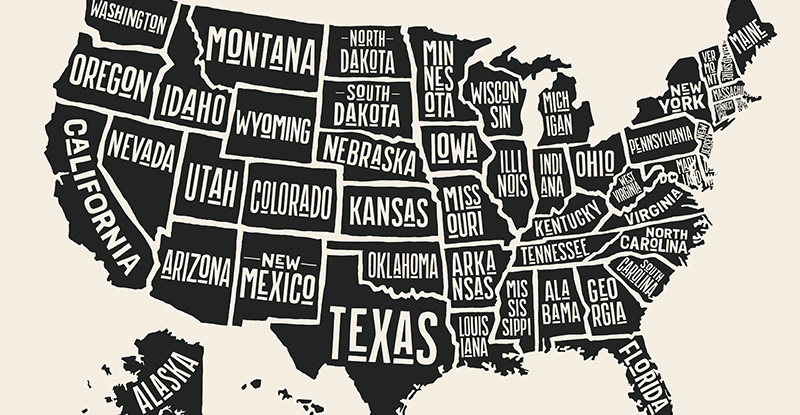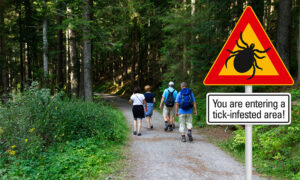What Is America’s Buggiest States?

When it comes to pest control, it pays to know America's buggiest states. Homeowners associations, in particular, have much to gain from this knowledge, as it can inform their pest control strategies. Understanding which states have the worst and what pests are more prominent than others can help tackle specific bug problems in their areas.
Browse By Category
Sign up for Our Newsletter
When it comes to pest control, it pays to know America’s buggiest states. Homeowners associations, in particular, have much to gain from this knowledge, as it can inform their pest control strategies. Understanding which states have the worst and what pests are more prominent than others can help tackle specific bug problems in their areas.
Revealing America’s Buggiest States
A recent analysis of Google searches for pests in the United States highlighted the states with the most prevalent pest issues. California topped the list with roughly 47,000 bug-related searches each month. Texas comes in second, with about 40,000 searches, and Florida in third, with approximately 32,000.
Here are the top 10 states with the highest pest-related searches in the U.S.
1. California
Pest-related searches in California totaled 46,790. Bed bugs made up 16,260 of those searches, with termites coming in close with 10,000 searches. Ants take the third spot with 8,710 searches, followed by cockroaches with 4,910 and spiders with 2,720. Among the list are mosquitos with 1,770, ticks with 1,240, and wasps with 1,180.
2. Texas
In Texas, searches related to pests reached a total of 40,860. Bed bugs led with 15,740 searches, followed by termites at 9,290. Ants secured the third spot with 6,230 searches, succeeded by cockroaches at 2,920 and mosquitos at 2,010. The list included spiders with 1,840, wasps with 1,580, and ticks with 1,250.
3. Florida
Florida recorded 32,210 searches related to pests, with termites being the most searched at 12,490, followed closely by bed bugs with 8,390 searches. In third place are ants with 3,830 searches, trailed by mosquitos at 2,670 and cockroaches at 2,260. The list concluded with spiders at 1,480, wasps at 600, and ticks at 490.
4. New York
New York comes in fourth with 22,190 total searches for pest-related issues. Bed bugs were the chief concern in the state, with 8,390 searches. Ants came in second with 4,710, and termites took the third spot with 3,180. Cockroaches followed close with 2,210. Finally, spiders with 1,100 searches, ticks with 970, mosquitos with 910, and wasps with 720 close out the list.
5. Pennsylvania
Pest-related searches in Pennsylvania totaled 15,850. Bed bugs made up 5,660 of those searches, with ants coming in close with 4,340 searches. Termites take the third spot with 2,570 searches, followed by cockroaches with 1,090 and spiders with 780. Rounding out the list are wasps with 560, mosquitos with 430, and ticks with 420.
6. Illinois
In Illinois, searches related to pests reached a total of 15,530. Bed bugs led with 6,790 searches, closely followed by ants at 3,670 searches. Termites secured the third spot with 1,680 searches, succeeded by cockroaches at 1,020 and spiders at 850. Completing the list were wasps with 590, ticks with 500, and mosquitos with 430.
7. Georgia
Georgia recorded 14,580 searches related to pests, with bed bugs being the most searched at 6,270, followed closely by termites with 2,570 searches. In third place are ants with 2,100 searches, trailed by mosquitos at 1,100 and cockroaches at 1,020. The list concluded with spiders at 770, wasps at 430, and ticks at 320.
8. North Carolina
North Carolina comes in eighth with 13,200 total searches for pest-related issues. Bed bugs were the primary concern in the state with 5,380 searches. Ants came in second with 2,370, and termites took the third spot with 2,310. Cockroaches followed close with 1,180. Finally, mosquitos with 670 searches, spiders with 580, wasps with 390, and ticks with 320 close out the list.
9. Virginia
Pest-related searches in Virginia totaled 11,400. Bed bugs made up 3,720 of those searches, with ants coming in close with 2,510 searches. Termites take the third spot with 2,260 searches, followed by cockroaches with 1,030 and mosquitos with 630. Rounding out the list are spiders with 560, wasps with 350, and ticks with 340.
10. Michigan
In Michigan, searches related to pests reached a total of 10,910. Bed bugs led with 5,060 searches, closely followed by ants at 2,020 searches. Spiders secured the third spot with 890 searches, followed by termites at 840 and cockroaches at 780. The list included mosquitos with 500, ticks with 430, and wasps with 390.
What Are the Most Searched Pests?
While it’s evident which are America’s biggest states, not all pests are equally troublesome. Some insects are hated more, and the data vividly shows this.
1. Bed Bugs
Bed bugs stand as the most undesirable pests among the American population. With a whopping 154,240 monthly searches, these bedroom intruders hold the distinction of being the most detested pests in the nation.
Nationwide, people are actively looking to expel bed bugs from their beds and homes, exploring various methods, from preventive measures to extensive extermination strategies. In 2010, the EPA and CDC collaborated to classify bed bugs as pests of significant public health concern.
Given how easily bed bugs can transfer, it’s clear why Americans despise them. While bed bugs aren’t known for transmitting diseases, their bites can induce severe itching, disrupting a restful sleep.
2. Ants
Small but terrible, ants claim the second position on the list. States such as California, New York, and Texas grapple with a pervasive ant issue. The diverse climate of California creates an ideal habitat for many ant species. In Texas, the formidable fire ant causes significant problems. Meanwhile, New Yorkers living in a dense city continue to seek solutions to prevent and address ant infestations.
From a health perspective, ants pose a recognized threat. These uninvited guests at picnics can transmit food-borne contaminants, including E. coli, salmonella, and shigella.
3. Termites
 California, Texas, and Florida struggle with a significant termite challenge. Fueled by Florida’s climate, California’s reliance on wooden architecture, and Texas’s weather conditions, these states provide optimal nesting conditions for these insects.
California, Texas, and Florida struggle with a significant termite challenge. Fueled by Florida’s climate, California’s reliance on wooden architecture, and Texas’s weather conditions, these states provide optimal nesting conditions for these insects.
Although termites don’t transmit diseases, they present other threats. Homeowners, in particular, harbor a strong aversion to termites due to their capacity to wreak havoc on wood structures.
4. Cockroaches
Cockroaches dominate search queries in California, New York, and Texas, thriving in urban environments and climates that serve as ideal breeding grounds for these troublesome insects. Beyond eliciting screams from people, cockroaches are notorious for carrying diseases. This list includes dysentery, typhoid fever, cholera, leprosy, listeriosis, coli, giardia, shigellosis, and more.
5. Spiders
Moving down the list, we encounter spiders. While not all spiders pose a threat, they still cause worries among Americans, especially in California, Florida, and Texas. These states offer conducive moist and warm climates, perfect for spiders.
Despite not being carriers of diseases, a spider bite or sting can cause considerable discomfort, including painful swelling, blistering, and itching. Some individuals may even experience allergic reactions requiring a hospital trip.
6. Mosquitos
The weather conditions in Florida create an ideal haven for mosquitoes, especially in South Florida. Weather patterns significantly contribute to the widespread presence of mosquitoes in Florida, California, Texas, and various other states.
Mosquito bites can result in unsightly and itchy marks. However, the harm doesn’t end there. Mosquitoes are vectors for diseases such as malaria, dengue, the Zika virus, the Chikungunya virus, and the West Nile virus.
7. Wasps
States with consistent mild weather and expansive outdoor activities, such as California, Washington, and Texas, often face more prevalent issues with wasps. Although wasps do not transmit human diseases, their stings can result in intense pain and occasionally lead to fatal allergic reactions. On average, wasp, bee, and hornet stings contribute to 72 deaths annually.
8. Ticks
 While ticks claim the final position on the list, it doesn’t make them any less threatening. Tick-borne diseases include Lyme disease, tularemia, Rocky Mountain Spotted Fever, ehrlichiosis, babesiosis, and more.
While ticks claim the final position on the list, it doesn’t make them any less threatening. Tick-borne diseases include Lyme disease, tularemia, Rocky Mountain Spotted Fever, ehrlichiosis, babesiosis, and more.
Given the health hazards associated with ticks, it’s understandable that states such as California, New York, and Texas regard them as a significant concern. The varied ecosystems, rural expanses, warm climates, and extensive outdoor areas in these states create optimal breeding grounds for ticks.
Are HOAs Responsible for Pest Control?
Homeowners associations are responsible for pest control in common areas and amenities. Here are what an HOA can do to prevent and address pests in the community.
1. Inspect Common Areas Regularly
Boards should ensure regular inspections of common spaces and facilities. These inspections can point out holes and gaps that pests can use as entry points. Inspections are even more critical in the spring when pests come out of hiding from the winter season.
2. Invest in Smart Landscaping
Strategic landscaping can help prevent a pest infestation. Think about using plants that scare away insects, such as lavender, mint, rosemary, and lemongrass. Moreover, HOA boards should make sure to trim lawns and foliage regularly. Drain any supply of stagnant water, as those as breeding spots for mosquitos and other insects.
3. Maintain Common Areas
Regular inspections uncover issues in communal areas, but HOAs must also take action. Boards must ensure the identified problems are addressed. This includes sealing any openings granting access to pests, appropriately disposing of trash that lures pests, and maintaining clean and flowing water sources.
4. Hire Pest Control Services
If an HOA is already dealing with an infestation, a pest control company can provide extermination services. Moreover, many pest control companies extend prevention services, including routine inspections, disinfection, and treatments.
5. Educate Residents
Responsibility for pest control in common areas lies with the HOA, but overall maintenance requires cooperation. Homeowners should maintain their individual properties and avoid contributing to pest issues. Boards should engage with residents, providing education on effective pest prevention. Some HOAs simplify the process by including pest control as part of homeowner dues.
Homeowner Tips to Prevent Spring Pests
Homeowners and HOAs may observe a reduction in pest issues during the winter, as some pests die in the cold, while others become less active. With pests thriving in warmer months, they often retreat underground or hide until spring. By the time the frost subsides, pests come out.
To prepare for potential spring pest challenges, consider the following steps:
- Seal any cracks or holes around exterior walls and openings to stop pests from entering the home.
- Initiate spring cleaning early to eliminate potential hiding spots for pests.
 Clean spaces around the exterior foundation that pests may use for food sources or shelter.
Clean spaces around the exterior foundation that pests may use for food sources or shelter.- Clear the garden by removing debris, dead plants, and weeds.
- Employ crop rotation and companion planting techniques to deter pests naturally.
- Ensure the soil is healthy and well-amended, enhancing resistance against pests.
- Water plants at the base to prevent damp conditions that attract pests.
- Regularly inspect plants for signs of pests.
- Consider using organic pest control products for the garden.
America’s Buggiest States Uncovered
There is no denying that pests can be a source of anxiety and frustration for many HOAs. Thus, proper pest control and prevention are necessary. Understanding America’s buggiest states will help inform an HOA board’s pest prevention and control measures decisions.
Are you looking for a pest control service in your area? Start browsing our online directory for vendors!
RELATED ARTICLES:
- Want To Switch To Artificial Grass? Here’s How To Do It
- 9 Landscaping Ideas For HOAs
- Mental Health Support In HOAs: Making It Available For The Community
Trending Now
Related Article
Sign up for Our Monthly Newsletter
Sign up below for monthly updates on all HOA Resource
















